NURS2172: Addressing Challenges in Take Home Naloxone Programs
VerifiedAdded on 2023/06/04
|8
|1736
|427
Essay
AI Summary
This essay examines the workforce and community challenges associated with the implementation of take-home naloxone programs, particularly in the context of opioid overdose prevention. It begins by introducing the goals of the program, including saving lives by reversing opioid-induced respiratory depression and reducing opioid-related fatalities. The essay identifies key challenges such as the user's fear of bystander incompetence, economic constraints related to training costs, legal obstructions concerning prescription and possession of naloxone, and stigma associated with opioid abuse. It then proposes strategies to address these challenges, including training healthcare providers on opioid overdose prevention, involving law enforcement in policy-making, securing funding for naloxone distribution, utilizing peer drug groups for education, and educating family members on naloxone administration. Furthermore, the essay highlights the importance of nursing education in the prompt reversal of opioid overdose and client education in the proper use of take-home naloxone kits, emphasizing the need for cooperation from government and stakeholders to ensure the program's success. Desklib offers a wealth of resources for students, including past papers and solved assignments to aid in their studies.

Running header:CHALLENGES FOR TAKE HOME NALOXONE 1
Workforce challenges for take home naloxone program
Name of author
Institutional affiliation
Workforce challenges for take home naloxone program
Name of author
Institutional affiliation
Paraphrase This Document
Need a fresh take? Get an instant paraphrase of this document with our AI Paraphraser
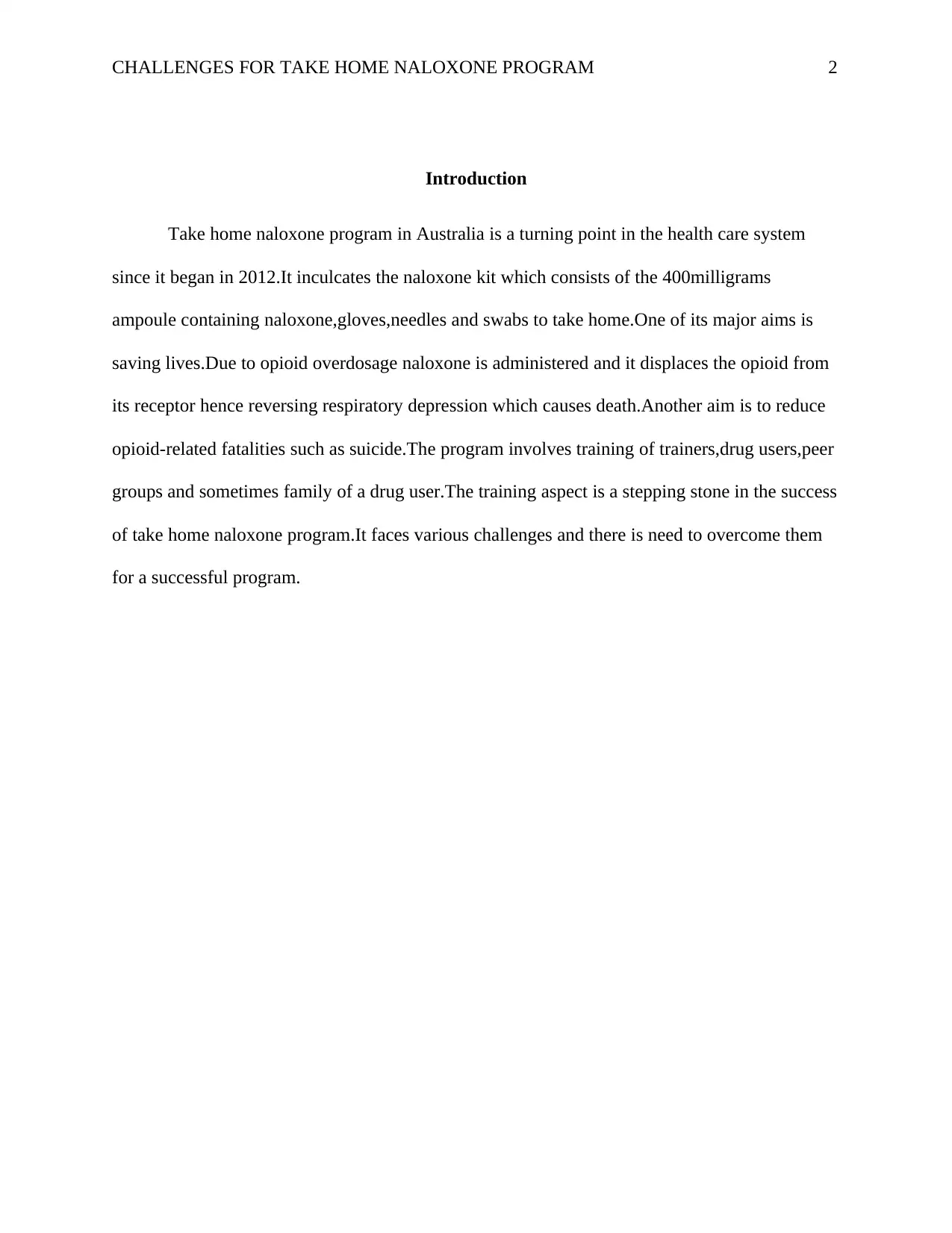
CHALLENGES FOR TAKE HOME NALOXONE PROGRAM 2
Introduction
Take home naloxone program in Australia is a turning point in the health care system
since it began in 2012.It inculcates the naloxone kit which consists of the 400milligrams
ampoule containing naloxone,gloves,needles and swabs to take home.One of its major aims is
saving lives.Due to opioid overdosage naloxone is administered and it displaces the opioid from
its receptor hence reversing respiratory depression which causes death.Another aim is to reduce
opioid-related fatalities such as suicide.The program involves training of trainers,drug users,peer
groups and sometimes family of a drug user.The training aspect is a stepping stone in the success
of take home naloxone program.It faces various challenges and there is need to overcome them
for a successful program.
Introduction
Take home naloxone program in Australia is a turning point in the health care system
since it began in 2012.It inculcates the naloxone kit which consists of the 400milligrams
ampoule containing naloxone,gloves,needles and swabs to take home.One of its major aims is
saving lives.Due to opioid overdosage naloxone is administered and it displaces the opioid from
its receptor hence reversing respiratory depression which causes death.Another aim is to reduce
opioid-related fatalities such as suicide.The program involves training of trainers,drug users,peer
groups and sometimes family of a drug user.The training aspect is a stepping stone in the success
of take home naloxone program.It faces various challenges and there is need to overcome them
for a successful program.
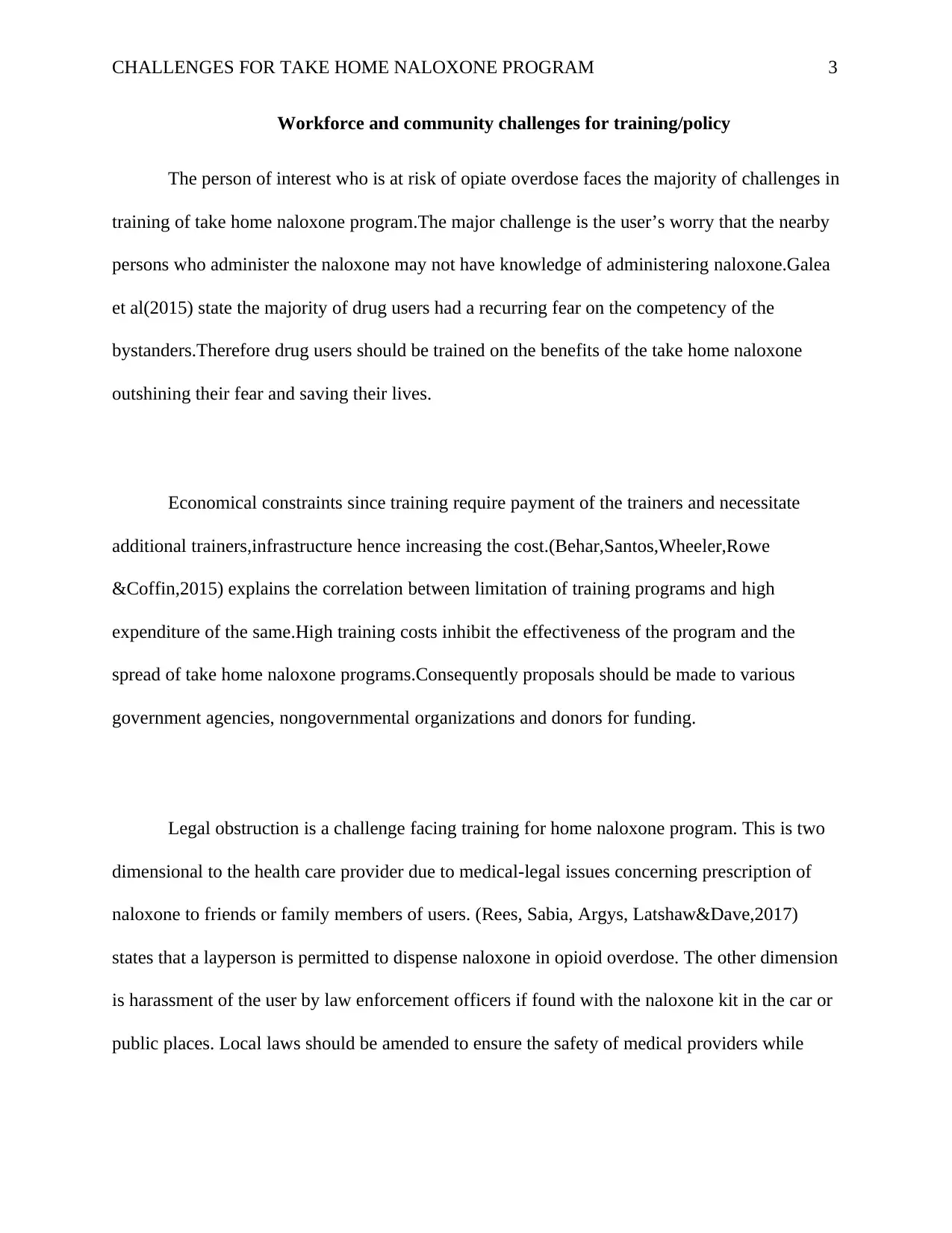
CHALLENGES FOR TAKE HOME NALOXONE PROGRAM 3
Workforce and community challenges for training/policy
The person of interest who is at risk of opiate overdose faces the majority of challenges in
training of take home naloxone program.The major challenge is the user’s worry that the nearby
persons who administer the naloxone may not have knowledge of administering naloxone.Galea
et al(2015) state the majority of drug users had a recurring fear on the competency of the
bystanders.Therefore drug users should be trained on the benefits of the take home naloxone
outshining their fear and saving their lives.
Economical constraints since training require payment of the trainers and necessitate
additional trainers,infrastructure hence increasing the cost.(Behar,Santos,Wheeler,Rowe
&Coffin,2015) explains the correlation between limitation of training programs and high
expenditure of the same.High training costs inhibit the effectiveness of the program and the
spread of take home naloxone programs.Consequently proposals should be made to various
government agencies, nongovernmental organizations and donors for funding.
Legal obstruction is a challenge facing training for home naloxone program. This is two
dimensional to the health care provider due to medical-legal issues concerning prescription of
naloxone to friends or family members of users. (Rees, Sabia, Argys, Latshaw&Dave,2017)
states that a layperson is permitted to dispense naloxone in opioid overdose. The other dimension
is harassment of the user by law enforcement officers if found with the naloxone kit in the car or
public places. Local laws should be amended to ensure the safety of medical providers while
Workforce and community challenges for training/policy
The person of interest who is at risk of opiate overdose faces the majority of challenges in
training of take home naloxone program.The major challenge is the user’s worry that the nearby
persons who administer the naloxone may not have knowledge of administering naloxone.Galea
et al(2015) state the majority of drug users had a recurring fear on the competency of the
bystanders.Therefore drug users should be trained on the benefits of the take home naloxone
outshining their fear and saving their lives.
Economical constraints since training require payment of the trainers and necessitate
additional trainers,infrastructure hence increasing the cost.(Behar,Santos,Wheeler,Rowe
&Coffin,2015) explains the correlation between limitation of training programs and high
expenditure of the same.High training costs inhibit the effectiveness of the program and the
spread of take home naloxone programs.Consequently proposals should be made to various
government agencies, nongovernmental organizations and donors for funding.
Legal obstruction is a challenge facing training for home naloxone program. This is two
dimensional to the health care provider due to medical-legal issues concerning prescription of
naloxone to friends or family members of users. (Rees, Sabia, Argys, Latshaw&Dave,2017)
states that a layperson is permitted to dispense naloxone in opioid overdose. The other dimension
is harassment of the user by law enforcement officers if found with the naloxone kit in the car or
public places. Local laws should be amended to ensure the safety of medical providers while
⊘ This is a preview!⊘
Do you want full access?
Subscribe today to unlock all pages.

Trusted by 1+ million students worldwide
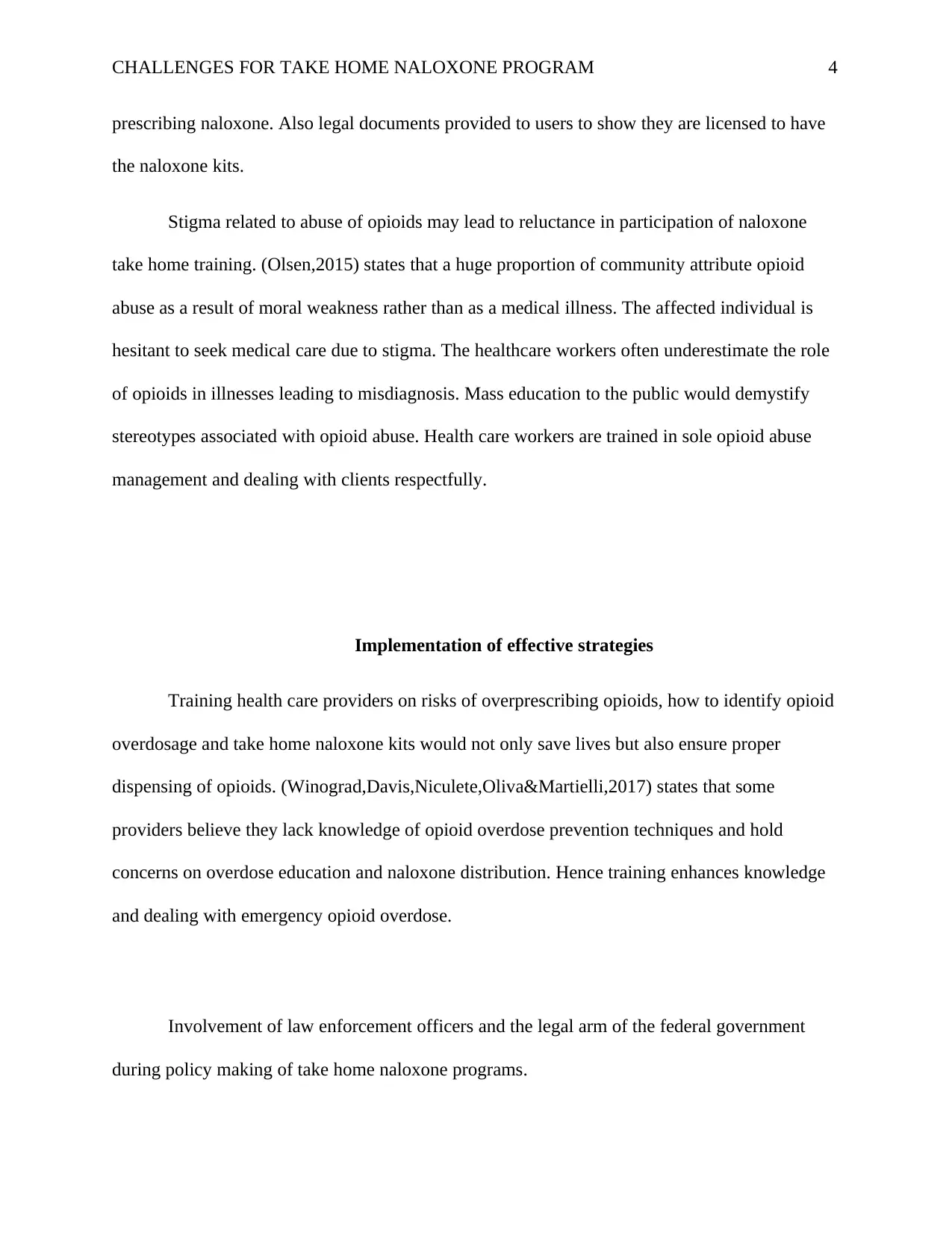
CHALLENGES FOR TAKE HOME NALOXONE PROGRAM 4
prescribing naloxone. Also legal documents provided to users to show they are licensed to have
the naloxone kits.
Stigma related to abuse of opioids may lead to reluctance in participation of naloxone
take home training. (Olsen,2015) states that a huge proportion of community attribute opioid
abuse as a result of moral weakness rather than as a medical illness. The affected individual is
hesitant to seek medical care due to stigma. The healthcare workers often underestimate the role
of opioids in illnesses leading to misdiagnosis. Mass education to the public would demystify
stereotypes associated with opioid abuse. Health care workers are trained in sole opioid abuse
management and dealing with clients respectfully.
Implementation of effective strategies
Training health care providers on risks of overprescribing opioids, how to identify opioid
overdosage and take home naloxone kits would not only save lives but also ensure proper
dispensing of opioids. (Winograd,Davis,Niculete,Oliva&Martielli,2017) states that some
providers believe they lack knowledge of opioid overdose prevention techniques and hold
concerns on overdose education and naloxone distribution. Hence training enhances knowledge
and dealing with emergency opioid overdose.
Involvement of law enforcement officers and the legal arm of the federal government
during policy making of take home naloxone programs.
prescribing naloxone. Also legal documents provided to users to show they are licensed to have
the naloxone kits.
Stigma related to abuse of opioids may lead to reluctance in participation of naloxone
take home training. (Olsen,2015) states that a huge proportion of community attribute opioid
abuse as a result of moral weakness rather than as a medical illness. The affected individual is
hesitant to seek medical care due to stigma. The healthcare workers often underestimate the role
of opioids in illnesses leading to misdiagnosis. Mass education to the public would demystify
stereotypes associated with opioid abuse. Health care workers are trained in sole opioid abuse
management and dealing with clients respectfully.
Implementation of effective strategies
Training health care providers on risks of overprescribing opioids, how to identify opioid
overdosage and take home naloxone kits would not only save lives but also ensure proper
dispensing of opioids. (Winograd,Davis,Niculete,Oliva&Martielli,2017) states that some
providers believe they lack knowledge of opioid overdose prevention techniques and hold
concerns on overdose education and naloxone distribution. Hence training enhances knowledge
and dealing with emergency opioid overdose.
Involvement of law enforcement officers and the legal arm of the federal government
during policy making of take home naloxone programs.
Paraphrase This Document
Need a fresh take? Get an instant paraphrase of this document with our AI Paraphraser
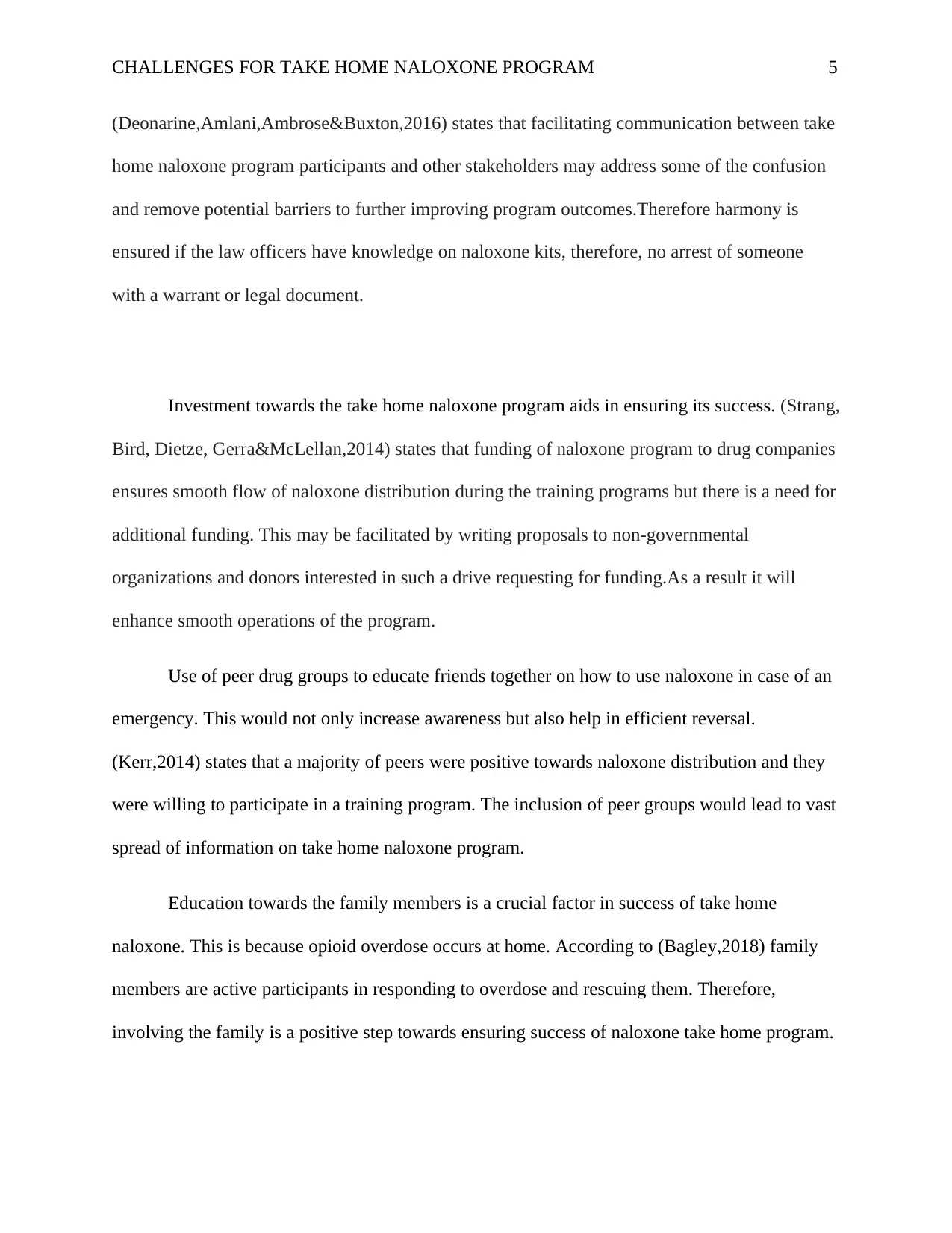
CHALLENGES FOR TAKE HOME NALOXONE PROGRAM 5
(Deonarine,Amlani,Ambrose&Buxton,2016) states that facilitating communication between take
home naloxone program participants and other stakeholders may address some of the confusion
and remove potential barriers to further improving program outcomes.Therefore harmony is
ensured if the law officers have knowledge on naloxone kits, therefore, no arrest of someone
with a warrant or legal document.
Investment towards the take home naloxone program aids in ensuring its success. (Strang,
Bird, Dietze, Gerra&McLellan,2014) states that funding of naloxone program to drug companies
ensures smooth flow of naloxone distribution during the training programs but there is a need for
additional funding. This may be facilitated by writing proposals to non-governmental
organizations and donors interested in such a drive requesting for funding.As a result it will
enhance smooth operations of the program.
Use of peer drug groups to educate friends together on how to use naloxone in case of an
emergency. This would not only increase awareness but also help in efficient reversal.
(Kerr,2014) states that a majority of peers were positive towards naloxone distribution and they
were willing to participate in a training program. The inclusion of peer groups would lead to vast
spread of information on take home naloxone program.
Education towards the family members is a crucial factor in success of take home
naloxone. This is because opioid overdose occurs at home. According to (Bagley,2018) family
members are active participants in responding to overdose and rescuing them. Therefore,
involving the family is a positive step towards ensuring success of naloxone take home program.
(Deonarine,Amlani,Ambrose&Buxton,2016) states that facilitating communication between take
home naloxone program participants and other stakeholders may address some of the confusion
and remove potential barriers to further improving program outcomes.Therefore harmony is
ensured if the law officers have knowledge on naloxone kits, therefore, no arrest of someone
with a warrant or legal document.
Investment towards the take home naloxone program aids in ensuring its success. (Strang,
Bird, Dietze, Gerra&McLellan,2014) states that funding of naloxone program to drug companies
ensures smooth flow of naloxone distribution during the training programs but there is a need for
additional funding. This may be facilitated by writing proposals to non-governmental
organizations and donors interested in such a drive requesting for funding.As a result it will
enhance smooth operations of the program.
Use of peer drug groups to educate friends together on how to use naloxone in case of an
emergency. This would not only increase awareness but also help in efficient reversal.
(Kerr,2014) states that a majority of peers were positive towards naloxone distribution and they
were willing to participate in a training program. The inclusion of peer groups would lead to vast
spread of information on take home naloxone program.
Education towards the family members is a crucial factor in success of take home
naloxone. This is because opioid overdose occurs at home. According to (Bagley,2018) family
members are active participants in responding to overdose and rescuing them. Therefore,
involving the family is a positive step towards ensuring success of naloxone take home program.
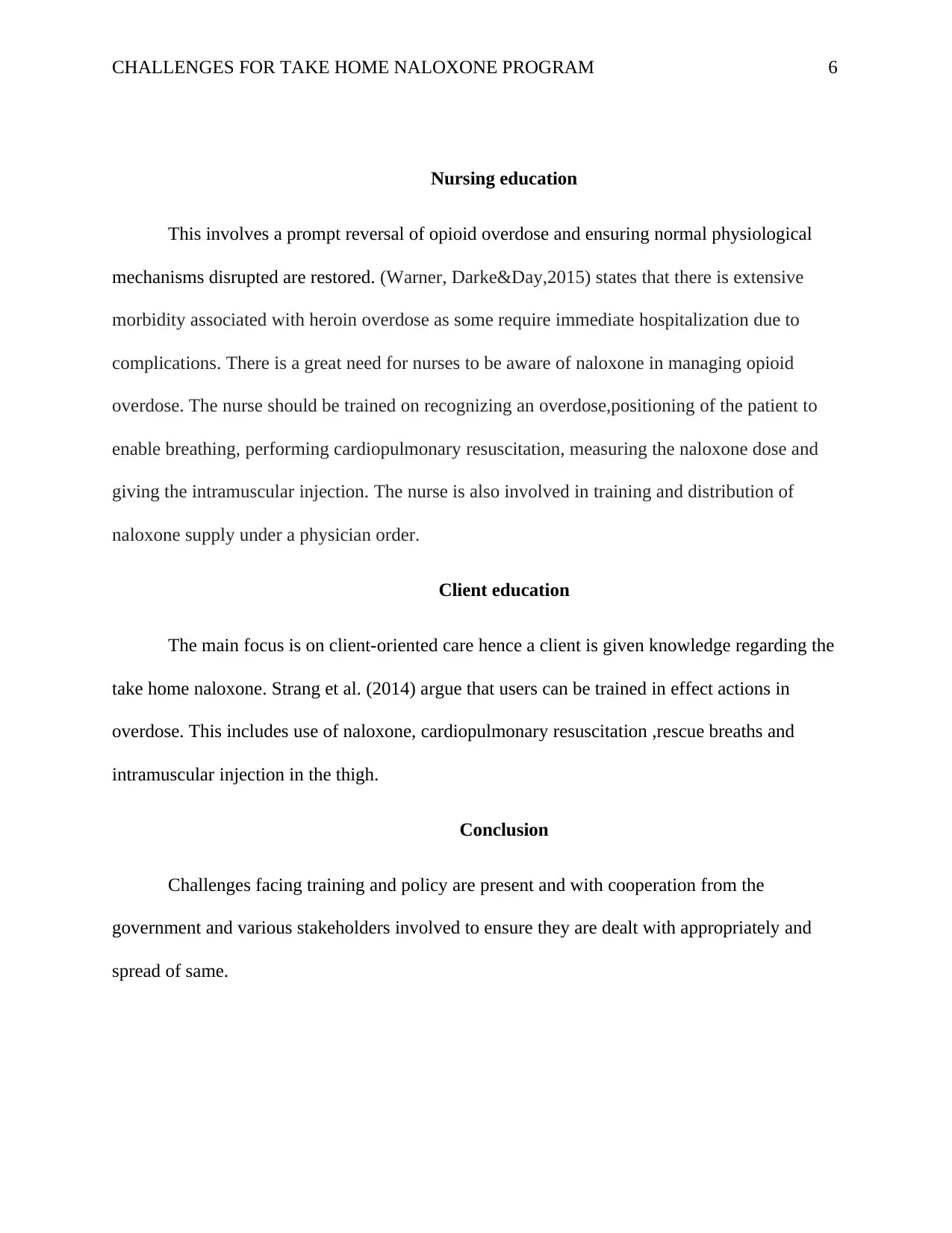
CHALLENGES FOR TAKE HOME NALOXONE PROGRAM 6
Nursing education
This involves a prompt reversal of opioid overdose and ensuring normal physiological
mechanisms disrupted are restored. (Warner, Darke&Day,2015) states that there is extensive
morbidity associated with heroin overdose as some require immediate hospitalization due to
complications. There is a great need for nurses to be aware of naloxone in managing opioid
overdose. The nurse should be trained on recognizing an overdose,positioning of the patient to
enable breathing, performing cardiopulmonary resuscitation, measuring the naloxone dose and
giving the intramuscular injection. The nurse is also involved in training and distribution of
naloxone supply under a physician order.
Client education
The main focus is on client-oriented care hence a client is given knowledge regarding the
take home naloxone. Strang et al. (2014) argue that users can be trained in effect actions in
overdose. This includes use of naloxone, cardiopulmonary resuscitation ,rescue breaths and
intramuscular injection in the thigh.
Conclusion
Challenges facing training and policy are present and with cooperation from the
government and various stakeholders involved to ensure they are dealt with appropriately and
spread of same.
Nursing education
This involves a prompt reversal of opioid overdose and ensuring normal physiological
mechanisms disrupted are restored. (Warner, Darke&Day,2015) states that there is extensive
morbidity associated with heroin overdose as some require immediate hospitalization due to
complications. There is a great need for nurses to be aware of naloxone in managing opioid
overdose. The nurse should be trained on recognizing an overdose,positioning of the patient to
enable breathing, performing cardiopulmonary resuscitation, measuring the naloxone dose and
giving the intramuscular injection. The nurse is also involved in training and distribution of
naloxone supply under a physician order.
Client education
The main focus is on client-oriented care hence a client is given knowledge regarding the
take home naloxone. Strang et al. (2014) argue that users can be trained in effect actions in
overdose. This includes use of naloxone, cardiopulmonary resuscitation ,rescue breaths and
intramuscular injection in the thigh.
Conclusion
Challenges facing training and policy are present and with cooperation from the
government and various stakeholders involved to ensure they are dealt with appropriately and
spread of same.
⊘ This is a preview!⊘
Do you want full access?
Subscribe today to unlock all pages.

Trusted by 1+ million students worldwide

CHALLENGES FOR TAKE HOME NALOXONE PROGRAM 7
References
Bagley, S. M., Forman, L. S., Ruiz, S., Cranston, K., & Walley, A. Y. (2018). Expanding access
to naloxone for family members: The Massachusetts experience. Drug and alcohol
review, 37(4), 480-486.
Behar, E., Santos, G. M., Wheeler, E., Rowe, C., & Coffin, P. O. (2015). Brief overdose
education is sufficient for naloxone distribution to opioid users. Drug and alcohol
dependence, 148, 209-212.
Deonarine, A., Amlani, A., Ambrose, G., & Buxton, J. A. (2016). Qualitative assessment of take-
home naloxone program participant and law enforcement interactions in British
Columbia. Harm reduction journal, 13(1), 17.
Galea, S., Worthington, N., Piper, T. M., Nandi, V. V., Curtis, M., & Rosenthal, D. M. (2015).
Provision of naloxone to injection drug users as an overdose prevention strategy: early
evidence from a pilot study in New York City. Addictive behaviors, 31(5), 907-912.
Kerr, D., Dietze, P., Kelly, A. M., & Jolley, D. (2014). Attitudes of Australian heroin users to
peer distribution of naloxone for heroin overdose: perspectives on intranasal
administration. Journal of Urban Health, 85(3), 352-360.
References
Bagley, S. M., Forman, L. S., Ruiz, S., Cranston, K., & Walley, A. Y. (2018). Expanding access
to naloxone for family members: The Massachusetts experience. Drug and alcohol
review, 37(4), 480-486.
Behar, E., Santos, G. M., Wheeler, E., Rowe, C., & Coffin, P. O. (2015). Brief overdose
education is sufficient for naloxone distribution to opioid users. Drug and alcohol
dependence, 148, 209-212.
Deonarine, A., Amlani, A., Ambrose, G., & Buxton, J. A. (2016). Qualitative assessment of take-
home naloxone program participant and law enforcement interactions in British
Columbia. Harm reduction journal, 13(1), 17.
Galea, S., Worthington, N., Piper, T. M., Nandi, V. V., Curtis, M., & Rosenthal, D. M. (2015).
Provision of naloxone to injection drug users as an overdose prevention strategy: early
evidence from a pilot study in New York City. Addictive behaviors, 31(5), 907-912.
Kerr, D., Dietze, P., Kelly, A. M., & Jolley, D. (2014). Attitudes of Australian heroin users to
peer distribution of naloxone for heroin overdose: perspectives on intranasal
administration. Journal of Urban Health, 85(3), 352-360.
Paraphrase This Document
Need a fresh take? Get an instant paraphrase of this document with our AI Paraphraser
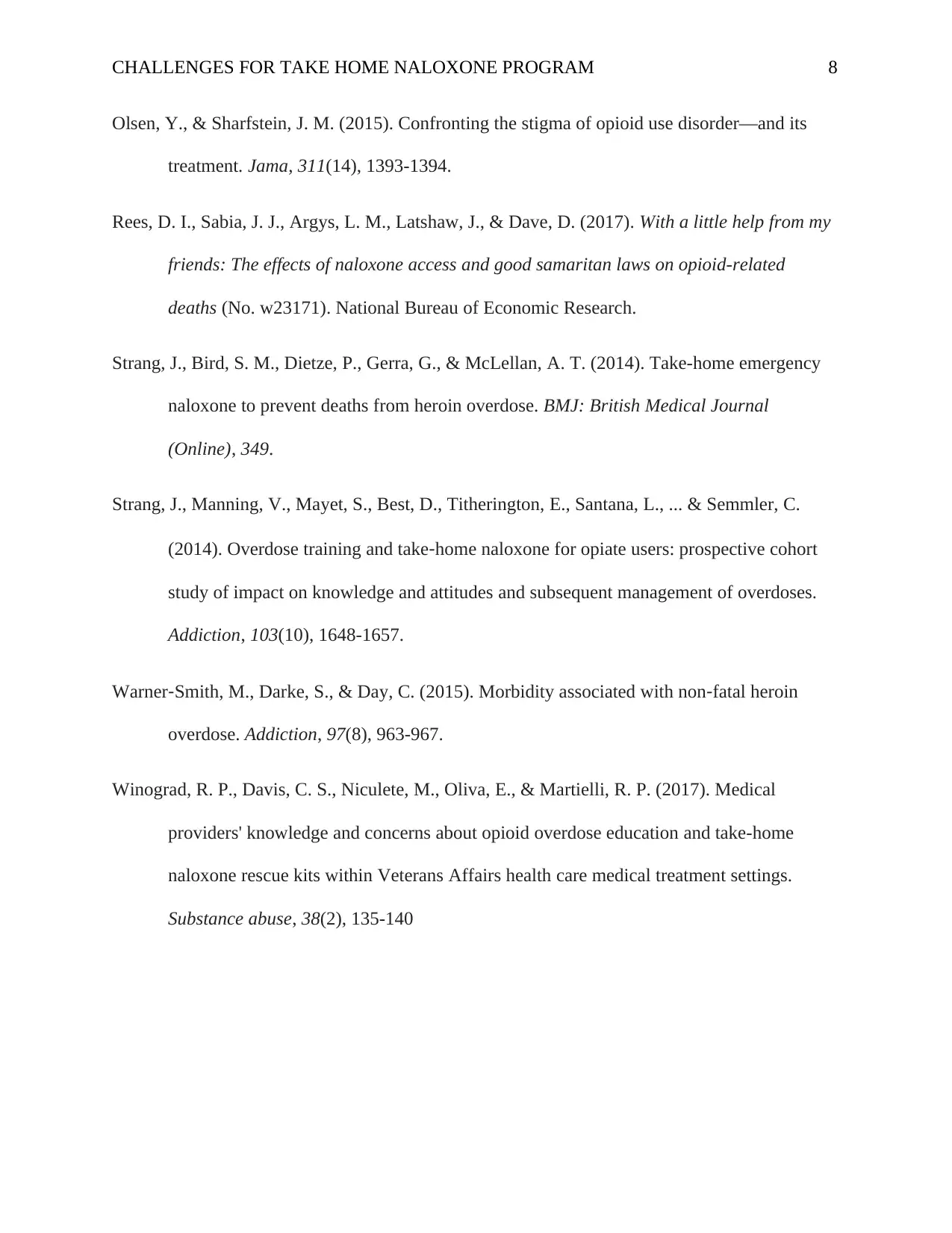
CHALLENGES FOR TAKE HOME NALOXONE PROGRAM 8
Olsen, Y., & Sharfstein, J. M. (2015). Confronting the stigma of opioid use disorder—and its
treatment. Jama, 311(14), 1393-1394.
Rees, D. I., Sabia, J. J., Argys, L. M., Latshaw, J., & Dave, D. (2017). With a little help from my
friends: The effects of naloxone access and good samaritan laws on opioid-related
deaths (No. w23171). National Bureau of Economic Research.
Strang, J., Bird, S. M., Dietze, P., Gerra, G., & McLellan, A. T. (2014). Take-home emergency
naloxone to prevent deaths from heroin overdose. BMJ: British Medical Journal
(Online), 349.
Strang, J., Manning, V., Mayet, S., Best, D., Titherington, E., Santana, L., ... & Semmler, C.
(2014). Overdose training and take‐home naloxone for opiate users: prospective cohort
study of impact on knowledge and attitudes and subsequent management of overdoses.
Addiction, 103(10), 1648-1657.
Warner‐Smith, M., Darke, S., & Day, C. (2015). Morbidity associated with non‐fatal heroin
overdose. Addiction, 97(8), 963-967.
Winograd, R. P., Davis, C. S., Niculete, M., Oliva, E., & Martielli, R. P. (2017). Medical
providers' knowledge and concerns about opioid overdose education and take-home
naloxone rescue kits within Veterans Affairs health care medical treatment settings.
Substance abuse, 38(2), 135-140
Olsen, Y., & Sharfstein, J. M. (2015). Confronting the stigma of opioid use disorder—and its
treatment. Jama, 311(14), 1393-1394.
Rees, D. I., Sabia, J. J., Argys, L. M., Latshaw, J., & Dave, D. (2017). With a little help from my
friends: The effects of naloxone access and good samaritan laws on opioid-related
deaths (No. w23171). National Bureau of Economic Research.
Strang, J., Bird, S. M., Dietze, P., Gerra, G., & McLellan, A. T. (2014). Take-home emergency
naloxone to prevent deaths from heroin overdose. BMJ: British Medical Journal
(Online), 349.
Strang, J., Manning, V., Mayet, S., Best, D., Titherington, E., Santana, L., ... & Semmler, C.
(2014). Overdose training and take‐home naloxone for opiate users: prospective cohort
study of impact on knowledge and attitudes and subsequent management of overdoses.
Addiction, 103(10), 1648-1657.
Warner‐Smith, M., Darke, S., & Day, C. (2015). Morbidity associated with non‐fatal heroin
overdose. Addiction, 97(8), 963-967.
Winograd, R. P., Davis, C. S., Niculete, M., Oliva, E., & Martielli, R. P. (2017). Medical
providers' knowledge and concerns about opioid overdose education and take-home
naloxone rescue kits within Veterans Affairs health care medical treatment settings.
Substance abuse, 38(2), 135-140
1 out of 8
Related Documents
Your All-in-One AI-Powered Toolkit for Academic Success.
+13062052269
info@desklib.com
Available 24*7 on WhatsApp / Email
![[object Object]](/_next/static/media/star-bottom.7253800d.svg)
Unlock your academic potential
Copyright © 2020–2025 A2Z Services. All Rights Reserved. Developed and managed by ZUCOL.





